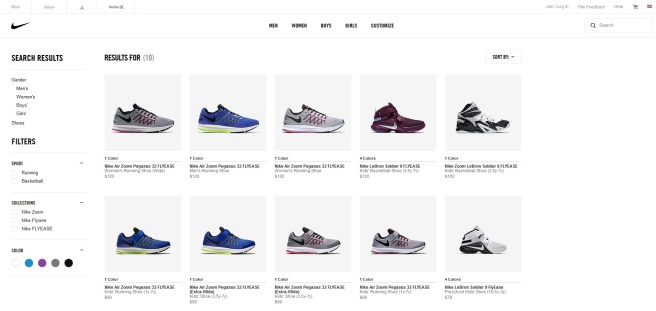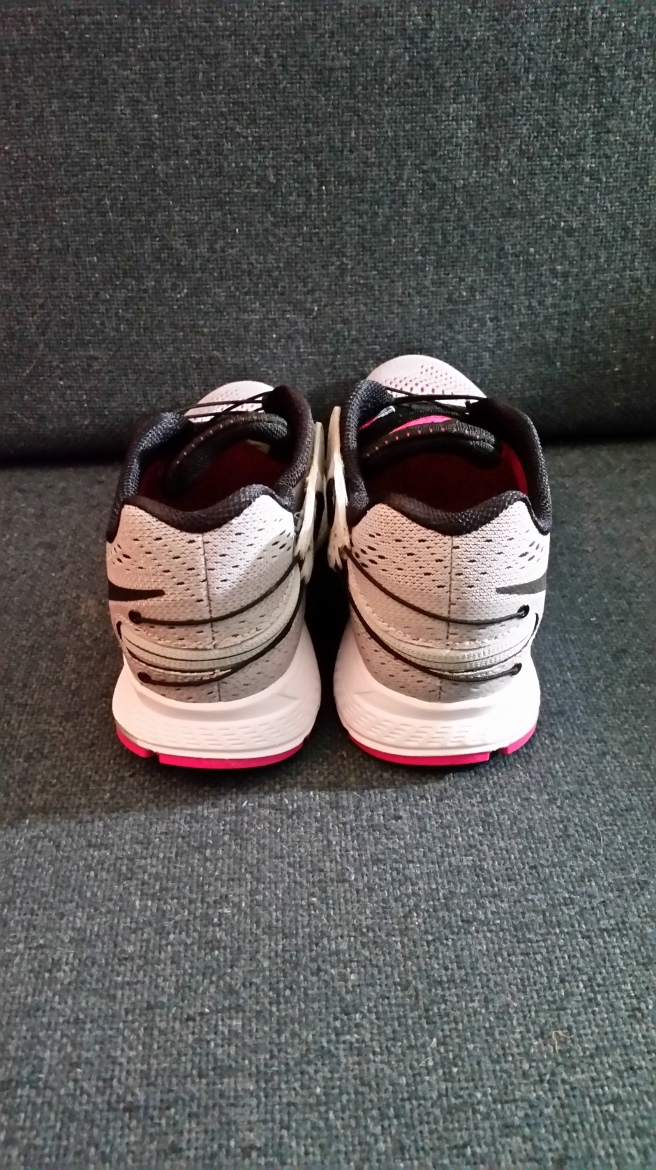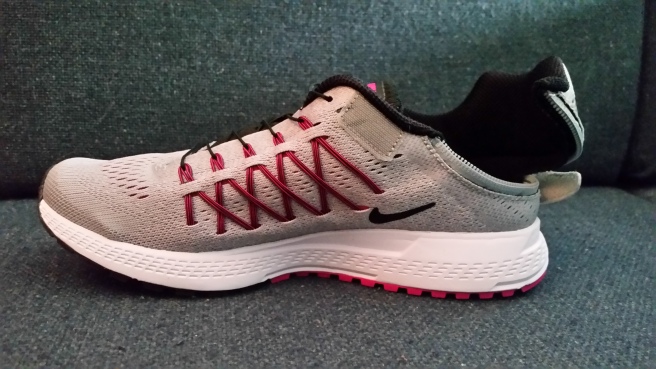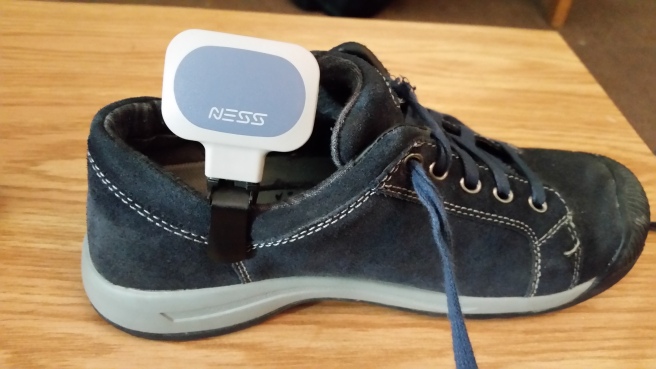When Nike released their heavily marketed shoes for disabled people in July of 2015, I was excited. All of the media (and there was a lot of media) proclaimed these shoes as being for disabled people. The thing was they really weren’t. At the time of their original release they were only available in men’s sizes 7 & up. This left out many women whose feet were to small (mine included). I wrote a post about it at the time, you can read it here. The shoes also didn’t come in children’s sizes. This meant that by and large the shoes were not for disabled people, they were for disabled men.
More recently Nike has expanded the line from the men’s basketball shoe to include men and women’s running shoes and children’s shoes. Selection unfortunately varies by country. In Canada where I am you can only buy medium width women’s running shoes while in the USA they also come in wide.
In Canada the selection of children’s shoes only includes basketball shoes while American children can also select running shoes.
The Canadian Nike website looks like this

Image description: A screenshot of the Nike online store for Canada showing the selection of shoes with Flyease technology. There are five pairs of shoes. Link to website here.
The American website looks like this

Image description: A screen shot of the American Nike online store showing the selection of shoes with Flyease technology. There are ten pairs of shoes. Link to website here.
There are even some countries where the shoes aren’t available at all like Australia.
I’ve been needing a new pair of gym shoes and decided to give the Nike’s a try now that they’re available in my size. They are only available online so I had to order them. They arrived last Friday and I’ve been wearing them for the last few days to get a sense of them.
First, I’m going to discuss why accessible shoes are so important to me.
Given the fact that I only have the full use of my right hand and only very little dexterity in my left, tying shoes is a time consuming chore. It’s also a skill I didn’t develop until well after my peers. I was around ten years old when I was finally able to tie my shoes well consistently but it still takes me at leat three times as long as nondisabled people.
I spent most of my early childhood wearing shoes done up with velcro. Unfortunately, this was the nineties, long before vecro actually started being used in fashionable shoes as a result, they were generally only available in sizes for toddlers, small children and adults (designed for the elderly. There were definitely a few years when I had outgrown the available children’s options but did not fit into adult shoes.
Despite what confused people on the internet seem to think, not everyone is falling over themselves to help disabled people when we genuinely need it (see the comments where people just can’t understand why I refuse to agree that disabled people should have to ask for prepared produce in this post on peeled oranges). So I had to graduate to laces but couldn’t actually deal with them. My mother didn’t want to be constantly tying my shoes for me, so she tied them loosely so that I could slip them on and off without untying them (this was not ideal as they were not a secure fit).
I distinctly remember one summer, going to a family event for my dad’s work, where one of his coworkers thought it would be hilarious to untie my shoes, admittedly, I’m sure he assumed I could retie them but I couldn’t ans my mum, dad and siblings weren’t close by so I just started to cry because I couldn’t really go anywhere until someone retied them for me.
As a kid I would have loved shoes that were accessible and designed to be fashionable. They wouldn’t have so obviously set me apart by having to wear shoes done up with velcro long after all of my peers had graduated to laces.
But back to the Nikes. Here’s what they look like

Image description: Front view of Nike’s Zoom Pegasus 32 Flyease running shoes. They are grey with magenta accents.
From the front, they appear like an average running shoe. The only hint that they might me different is that the laces are thin and have no visible way of adjusting them. This is because the laces are actually internally threaded through the shoes and are connected to the back zipper seen here

Image description: rear view of the Nike Zoom Pegasus 32 shoes. The zipper closure id visible along the heel of the shoe while the strap is attached on the inner side of the shoe, it is attached to the lace string which is visible on either side of the zipper.
The shoes are unzipped to allow the foot to enter and exit from the heel.

Image description: Back view of an unzipped Nike Zoom Pegasus 32

Image description: Side view of an unzipped Nike Zoom Pegasus 32. The heel is visibly separated from the shoe to allow top and rear access.
The wearer can then slide their foot into the shoe, you have to have your foot shoved as far forward as possible and then the zipper can be pulled across and the zipper strap secured with velcro.
When I bought these shoes, my intention was to particularly look at how well these shoes work with various orthotic devices. I have an Ankle Foot Orthosis (AFO), a Bioness L300 and a basic custom insole to compensate for leg length discrepancy. I was going to check how well these shoes worked with each device and report back with pictures. The problem is that these shoes don’t accommodate any of them.
I first tried the shoes with just my lift

Image description: a black custom made orthotic lift designed to compensate for leg length discrepancy.
After I had inserted the insole, I could barely get the shoe zipped up and the fit was so tight it hurt. I had to remove it. I suspect the shoes might work with a heel lift wedge, which is less invasive but I don’t have one at the moment and will have to find a supplier in Toronto.
I didn’t even bother trying the AFO because it takes up way more space in the shoe and I suspected trying might damage the zipper.
The heel sensor for A Bioness L300 isn’t as invasive as my lift (but I need to use the two things together). Even without the lift, the Bioness (you can read my thoughts on that product here) still isn’t compatible with these Nikes because the heel sensor has to be clipped to the inner side of the shoe.

Image description: A blue shoe with the Bioness L300 sensor clipped in proper position over the ankle on the inner side of the shoe.
As you will recall, the Nikes zip to the inside and the zipper would get in the way of where the sensor needs to be clipped. Not only does the clip require significan dexterity in at least one hand to operate, it also include internal spikes to hold it firmly in place. It is difficult to remove which detracts from the needed accessibility of the shoe and repeated removals and replacements would likely damage the zipper of the Nikes.
So these shoes are really only useful for people who have no additional orthotic needs. I’m not sure if the wide version of the shoes would better accommodate a lift but i can’t find out as that version of the shoe isn’t available in Canada. The basketball shoe may also provide more space but it isn’t available in my size so I’m not sure.
Now on to the merits of the shoes themselves.
They can indeed be zipped up one handed, but that hand will need some strength and dexterity. The motion isn’t smooth and requires some maneuvering but definitely took me less time than tying laces.
I could however only zip them with my right hand. My left hand could neither negotiate the zipper or the velcro, so be aware of that before ordering. Some hand dexterity and strength is required to properly operate the zipper.
Due to my hemiplegia my left foot is significantly smaller than my right but the shoe still fit comfortably despite my buying the size for my right foot.
That being said, be aware that the tightness of the shoe can’t really be adjusted. As I mentioned above the top laces are attached to the zipper, so if you loosen the shoe, you won’t actually be able to zip it up. You can tighten then a bit but it’s finicky and requires dexterity. I find this to be a major design flaw. The shoes really need to have top laces that can be tightened or loosens independent of the zipper. Doing that might make them more usable with orthotics, though as long as they zip to the inner side, they won’t be compatible with anything like the Bioness.
Other thoughts
While there is an inner covering to protect the foot from the zipper, I highly recommend that people wear socks as the zipper is hard and may irritate your foot.
Conclusions
These shoes are best suited to people who either have the full use of one hand or only minor limited dexterity. They are also best suited to people who don’t use orthotics of any kind.
As with my original thoughts on the Nike accessible shoes back when they were only designed for men, I maintain my conclusion that the claim that these shoes are for disabled people generally is false. They will meet the needs of only a very small portion of the disabled population. I unfortunately can’t really see Nike trying to rectify that any time soon or ever as they are to heavily invested in “Hey we identified a problem for disabled people and we fixed it!” style advertising. They are unlikely to acknowledge that in order to make a more widely accessible shoe, much more work needs to be done.
It is clear that they considered the needs of an individual (see the video in my previous post for background on how the shoes came to be) and didn’t really consider that an individual’s needs are not representative of the scope of people they have now claimed to cater to.
For these shoes to be more accessible they would need to zip to the outside edge (so as to be compatible with a Bioness), they would need to be able to accommodate a variety of orthotics. The shoes also need a mechanism to independently manage the tightness of the shoes that isn’t attached to the zipper. This last one might actually rectify the orthotic situation, at least for insole type orthotics, though likely not an AFO.
Ultimately, I do think these shoes will be good for some people and I will be able to use them as gym shoes because, running and cycling don’t aggravate issues caused by my leg length difference the way walking does but I won’t be able to use them for everyday use (unless I can get my hands on a heel wedge and it works, I’ll report back if I do).
The biggest issue isn’t even how limited the consumer base is with these shoes. They will definitely help some people. I would have loved them as a kid, back before I became an adult and my body was more forgiving of not wearing my corrective orthotics. Nothing is universally accessible and it’s unreasonable to expect a single thing to cater to all disability needs. The biggest issue is that in all the media, the shoe is presented as though it does fix all those problems. It’s the shoe for people with disabilities. Not the shoe for people with very specific needs because admitting that means that Nike admits to leaving people out.
The thing is we need to acknowledge that these shoes while a step in the right direction DO still leave people out and those people deserve to have their needs catered to. The first step in that direction is for people to express their needs and to have manufacturers acknowledge them and commit to working toward fixing them. The “Hey look we fixed it” mentality and overly inclusive language put out by Nike and happily parroted by the mainstream media are a major barrier in moving forward with further progress and it’s a barrier that needs to be knocked down.
How to support my work
If you liked this post and want to support my continued writing please consider becoming a patron on patreon.
If you can’t commit to a monthly contribution consider buying me a metaphorical coffee (or two or more). Contributions help me keep this blog going and support my ongoing efforts to obtain a PhD.
If you want to support my work but are unable to do so financially, please share this post on you various social media accounts.

I’m looking at these shoes, and I see a big barrier. It’s assuming you can easily touch your heel to zip them up. My disability is minor, but it involves misshapen femurs that can make it difficult to reach my heels.
LikeLike
I also awaited the release of these shoes and was disappointed that there were no women’s shoes available. I see now only one women’s option. My daughter with CP is 14 and very conscious of style. I wish there were some more options. Do you think Nike is going to release more styles? We live in Israel complicating things a bit as the stores here generally lag behind in availability.
LikeLike
I read this ages ago and thought of your daughter when searching for my own shoes. This woman makes unconventional but nice shoes, http://intothewildway.squarespace.com and Mik at thoseshoes.com will also custom make cool shoes. Etsy increasingly has nice custom shoes, Jurga from Latvia made a nice pair of wool boots for me.
LikeLike
I was considering these for my son (4 years old). Not sure that I will now. But I also just found these magnetic shoe lace latches online… might try these first because they can be used on any shoe https://zubits.com/
LikeLike
Take a look at http://www.quikiks.com
LikeLike
Thank you for your review I had read the hype and got excited that people’s needs were being addressed but I can see ther s still a long way to go
LikeLike
I, too can see how difficult the Nike shoelaces and back zipper can be difficult to maneuver. I am also wearing the Bioness leg cuff and cannot find a shoe to accommodate my neuropathy and many other difficulties dealing with MS. Every day is a struggle getting around and if I could only find a comfortable sneaker, it would make me a happier woman.
LikeLike
I thank you for your honesty. My son has CP and has started a nonprofit in the US to give shoes free to disabled or we say differently abled in our community. He too was so frustrated with tying shoes PLUS he wears AFO’s. Shoes have always been a struggle for us. We are constantly looking for solutions. We dream of being able to design footwear that is both feasible (financially & physically) as well as attractive. We get asked by non disabled what’s the problem or have you tried Nike etc…
We haven’t been able to even try the Nike because they never have my son’s size in stock or available.
I’d welcome your shoe reviews for our Facebook page. SoulStrapd
LikeLike
Thank you so much for your detailed review! I was looking into these for my 15 year old son that wears AFO’s. I’ve decided these will not work:( Good luck to you!
LikeLike
I have been looking all over for these shoes in a kids size 12 and I can’t find them. I think it is really unfair that Nike would make a shoe in a limited amount and sizes. It seems to me that the makers of the FlyEase thinks that there a limited amount of children with Special Needs that are fashion savvy. It hurts because my son is already limited to the things outside of his norm now he has to be limited to a brand of as well. Get it together Nike you seem to make thousands of Jordan’s why not try making half the amount of the FlyEase in all colors, and sizes as well.
LikeLike
I am sorry that these didn’t work for your needs but they have been great for myself and others that I know. My uncle is the one that showed me the shoes. My uncle has MS and these have started allowing him to completely gay himself dressed. He did complain a bit at first about the zipper but now that he has worn them a bit the zipper is a non issue. The show also works well with his apparatus that he wears that clips to the shoe to correct his drop foot. He loves them. My uncle showed his PT and she as recommended them to many of her other patients. I got my pair because I have severe nerve damage and drop foot on one side due to a severe injury. I have problems getting my foot in a normal shoe because I can’t move my foot and toes to wiggle my foot into a shoe. I love them and would order a couple more pair if there were more color choices. B Because I was a major shoe lover before my injury and still am except now my collection is all tennis shoes and sneakers. The last person I know that uses them is my friends daughter with spinal bifida and they work well with the braces she wears. She is 8 and likes that mine and hers match when we go places lol. The only thing I wish is that I wouldn’t have had to order them and could have tried them on in store took me a couple pair to get the right fit and I wish for more choices of colors.
LikeLike
Mik over at thoseshoes.com has made a variety of custom shoes for specific foot and leg size requests. The shoes are expensive, but they last forever. We have also had success lacing minimalist shoes like Vivo with elastic cord.
LikeLike